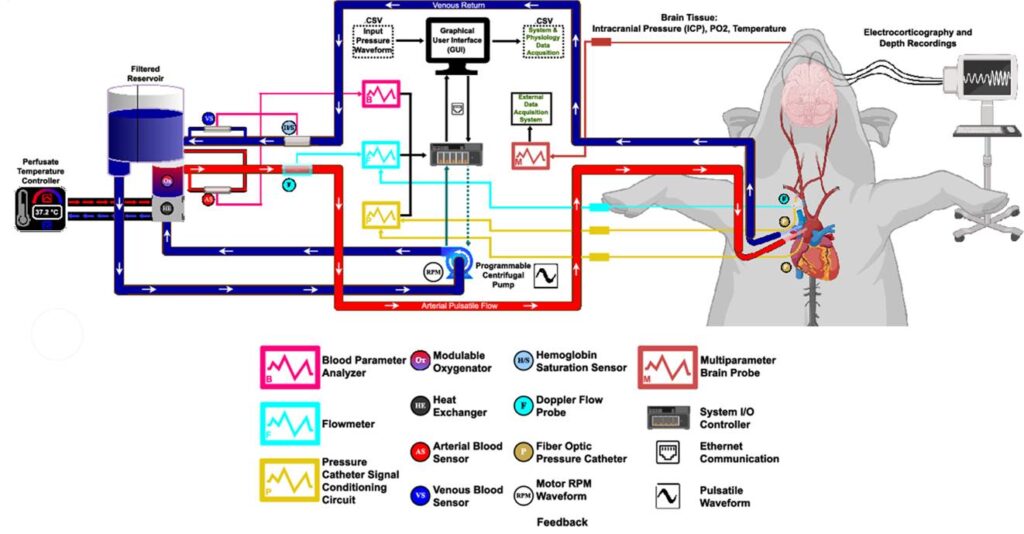The brain is a complex organ, and its capabilities are quite challenging and fascinating to scientists and researchers. Isolating the function of the brain can help in investigating various aspects of brain activity and the mechanisms underlying neurological disorders. Discover how this innovative device is revolutionizing research by isolating and understanding brain functions like never before.
| Publish date | November 02, 2023 |
| Source | UT Southwestern Medical Center |
| Summary | It is a device developed to keep the brain alive and sustaining its function independently from the rest of the body. The device does this by isolating the blood flow to the brain. |
| Professionals involved in the development | Neuroscientists, Biomedical Engineers, Neurosurgeons, Cardiologists. |
Aksharkumar Dobariya, M.S., Graduate Student Researcher in Biomedical Engineering and Sourav Patnaik, Senior Biomedical Engineering Specialist are the two biomedical engineers who contributed to the development of the device.
Need for the technology
The brain serves as the master controller for various bodily functions. It regulates heart rate, respiration, and sleep-wake cycles. On the other hand, internal body factors such as blood sugar, blood pressure, and oxygenation affect the function of the brain. Till now, there has been no technology available to isolate the brain from the body to study how these factors influence the function of the brain.
Manipulating the blood flow to the brain enables us to investigate the function of the brain under ischemia and stroke conditions. It also facilitates the study of the action and distribution of pharmacological agents and metabolic tracers. By isolating the brain, it is possible for the researchers to manipulate inputs to this organ and observe how they influence its function without the influence of the body.
Technology Details
The researchers tested the device using a pig brain model. They administered anesthesia to the animal models and redirected the brain’s blood supply through a pump. This pump regulated various factors like blood pressure, volume, temperature, oxygen levels, and nutrients. The brain activity and other measurements remained mostly stable or showed hardly any changes throughout a five-hour period.
Monitoring, anesthesia and intravenous fluids
The surgeons anesthetized subjects 1 and 2 (pigs). They maintained the respiratory rate at 15–20 breaths per minute using an animal respirator. Also, they monitored heart rate, arterial blood pressure, respiratory frequency, pulse oximetry and capnography, and ensured stability. They administered saline solution continuously through an IV at a rate of 50 milliliters per hour.
Cerebral exposure and recording
The surgeons positioned the anesthetized pigs on an operating table and prepared the heads of the pigs for cranial surgery. Then, they removed a section of the skull to place the electrodes on the brain’s surface and depth. Further, they inserted a brain probe for monitoring temperature, pressure, and oxygen saturation. Then, they closed the scalp and documented the electrode positions. Neurophysiological recordings were conducted using a clinical 32-channel amplifier in a controlled environment. Custom MATLAB scripts analyzed the data from all recording electrodes.
EPCC apparatus
The isolation of brain function using extracorporeal pulsatile circulatory control (EPCC) involves directing or controlling blood flow to the brain while maintaining circulation in the rest of the body. This can be achieved by adjusting the EPCC parameters to regulate the flow directed to the brain while monitoring and controlling factors such as pressure, oxygenation, and flow rate.
Researchers used an analog programmable centrifugal pump (BVP-ZX, Harvard Biosciences) as the motor for the extracorporeal pulsatile circulatory control (EPCC) apparatus. It generated pulsatile waveforms mirroring native physiological pressure recordings. The pump regulated blood flow using a magnetic impeller motor, and connected to it was a specialized pump head (BP-80, Medtronic) that minimized damage to blood cells.

Results
Under EPCC, cerebral activity was sustained for a period of five hours throughout each subject’s study period. The researchers have used the device to study the effects of hypoglycemia (low blood sugar) without the influence of other factors. This innovative device employs a pulsating flow to deliver blood, which resembles the human heart. As a result, it may be possible to prevent brain-related side effects commonly associated with cardiopulmonary bypass machines.
Future Work
The researchers have analyzed the performance of EPCC for 5 hours. Hence, the study can be extended to durations greater than 5 hours. This enables us to analyze the performance of EPCC for a much longer period of time.
Citation
Muhammed Shariff et al, Maintenance of pig brain function under extracorporeal pulsatile circulatory control (EPCC), Scientific Reports (2023). DOI: 10.1038/s41598-023-39344-7
Isolating cerebral activity holds a greater potential for exploring and understanding its mysteries, as well as in the treatment of neurological disorders.
For more recent developments in Biomedical Engineering, https://onestopbiomedical.com/category/recent-technology/
Subscribe to my newsletter
Stay updated with my latest blogs
